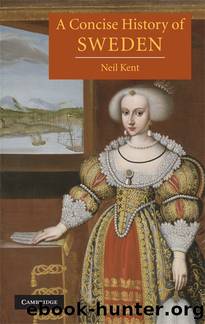A Concise History of Sweden - Cambridge Concise Histories by Neil Kent

Author:Neil Kent [Neil Kent]
Language: eng
Format: epub
Publisher: Cambridge University Press
Published: 2008-06-11T22:00:00+00:00
Gustaf IIIâs reforms
With scepticism and Enlightenment values coming to the fore in other realms than just the musical, Gustaf III took the initiative to rid the country of laws promulgated in what he considered to be a more superstitious age. In 1779, he repealed those laws relating to witchcraft and in other ways sought to temper the religious intolerance of the age, but only in so far as public opinion and the clergy of the Church of Sweden would allow. The practice of Catholicism remained forbidden to Swedes, but Catholic immigrants whose labour the country needed were now allowed to do so. In 1782, Jews, too, were finally permitted to come and settle in Sweden, where henceforth they were allowed to practise their religion privately. They were permitted to settle in Stockholm, Gothenburg, Norrköping and Karlskrona but this only applied to those Jews with the means and skills deemed sufficient to carry out trade and industry productively. Moreover, their rights were circumscribed: membership of craft guilds, the ownership of landed property and intermarriage remained prohibited to them. Poorer unskilled Jewish labour continued to be unwelcome until the middle of the nineteenth century.
Gustaf was also interested in prison reform. The English prison reformer John Howardâs notable work The State of the Prisons in England and Wales, published in 1777, was especially influential in encouraging this initiative. It also inspired David Schultz von Schultzenheim, the Prussian who had introduced smallpox inoculation into Sweden in the 1750s, to advocate a range of improvements for dealing with prisoners and their reform. Nearer to home, local Swedish initiatives with respect to prison reform were also influential. In particular, a new model prison designed by the famous Swedish architect Gustaf af Sillén (1762â1825) won wide approval for its reformist vision, a three-storey edifice, in which hardened and lesser criminals were separated from one another, with a chapel situated between the two principal wings, the only venue in the complex in which all were permitted to assemble.
Most acclaimed at the time, at least by Enlightenment thinkers abroad, was Gustafâs abolition of the use of torture, enacted during the early years of his reign. This won him the approbation of Voltaire and, among many of the philosophes of the Englightenment, Gustaf III came to be lauded as a true philosopher-king, joining the ranks of such âbenevolent autocratsâ as Catherine the Great of Russia and Frederick the Great of Prussia.
Download
This site does not store any files on its server. We only index and link to content provided by other sites. Please contact the content providers to delete copyright contents if any and email us, we'll remove relevant links or contents immediately.
| Africa | Americas |
| Arctic & Antarctica | Asia |
| Australia & Oceania | Europe |
| Middle East | Russia |
| United States | World |
| Ancient Civilizations | Military |
| Historical Study & Educational Resources |
Magic and Divination in Early Islam by Emilie Savage-Smith;(1498)
Ambition and Desire: The Dangerous Life of Josephine Bonaparte by Kate Williams(1343)
Bohemians, Bootleggers, Flappers, and Swells: The Best of Early Vanity Fair by Bohemians Bootleggers Flappers & Swells- The Best of Early Vanity Fair (epub)(1341)
Papillon by Henry Charrière(1308)
Twelve Caesars by Mary Beard(1255)
Operation Vengeance: The Astonishing Aerial Ambush That Changed World War II by Dan Hampton(1134)
What Really Happened: The Death of Hitler by Robert J. Hutchinson(1127)
London in the Twentieth Century by Jerry White(1111)
Time of the Magicians by Wolfram Eilenberger(1086)
The Japanese by Christopher Harding(1085)
Twilight of the Gods by Ian W. Toll(1083)
Lenin: A Biography by Robert Service(1042)
The Devil You Know by Charles M. Blow(984)
A Social History of the Media by Peter Burke & Peter Burke(936)
Freemasons for Dummies by Hodapp Christopher;(921)
Napolean Hill Collection by Napoleon Hill(902)
Henry III by David Carpenter;(890)
The Churchill Complex by Ian Buruma(879)
The Rise and Triumph of the Modern Self by Unknown(877)
